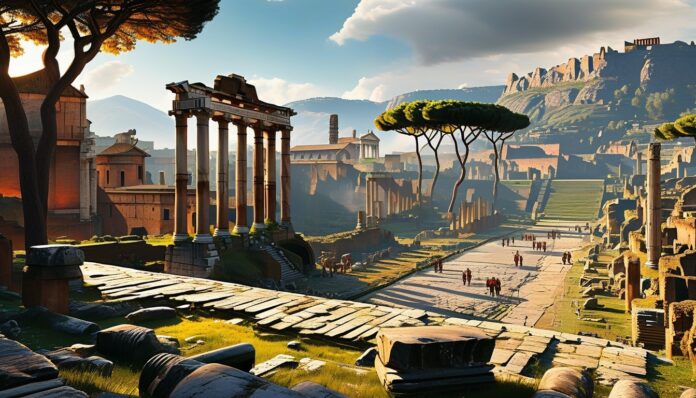The civilization of Ancient Rome gave the world not only unique architecture that remains unmatched to this day. The fallen empire was the cradle of Christianity and the birthplace of great poets and philosophers who laid the foundations of many modern sciences.
This mighty state, which stretched far beyond the Mediterranean, is shrouded in legends. Some facts are so surprising they seem mythical, although their truth is beyond doubt.
- A day in Ancient Rome was divided into 24 hours, but the length of each hour varied depending on the season and the length of daylight. In summer, an hour could last 80 minutes, while in winter it was as short as 44.
- The Roman elite spoke not only Latin but also Greek, a sign of noble origin. When aristocratic conspirators killed Julius Caesar, they shouted in Greek.
- Contrary to popular belief, gladiator fights were not the most favored entertainment in Ancient Rome. The people preferred chariot races. The Colosseum held 50,000 spectators, while the Circus Maximus, where races took place, could accommodate 250,000 people.
- The blood of slain gladiators was sold as a cure for infertility and epilepsy.
- About a hundred warriors died in the Colosseum each month.
- Until 200 AD, women—both slaves and noblewomen—were allowed to participate in gladiator fights.
- In the 1st century AD, one popular spectacle involved battles between polar bears and seals in flooded amphitheaters.
- A famous animal trainer, Carpophorus, entertained the crowds by training wild beasts to kill people in horrific ways. His cruelty, especially toward women, made his name infamous.
- The average life expectancy in Ancient Rome didn’t exceed 30 years. Men often died in wars, and women and infants frequently died in childbirth. However, those who survived into adulthood had a good chance of living to old age.
- The Roman Empire wasn’t the largest in human history. At its peak, 12% of the world’s population lived within its borders, ranking it 28th. The top spots go to the British, Mongol, and Russian empires.
- Slaves made up as much as 40% of the population. During the festival of Saturnalia, they were freed from heavy labor, fed at their masters’ tables, and allowed to wear their masters’ clothing.
- Only citizens could participate in military operations; it was their duty to defend the state. Slaves were not used even as galley rowers unless they were promised freedom beforehand.
- At the height of its power, the empire covered 4.4 million square kilometers and had a population of 65 million people—six times denser than modern-day New York City.
- Romans were polytheists, worshipping many gods—not only Jupiter, Mars, and Vesta, but also unexpected deities like the goddess of sewers, the god of toilets, and the god of excrement. People believed these mythical beings often visited lavatories.
- Urine was used to clean clothes and whiten teeth.
- Roman dentists were able to make and insert dental prosthetics.
- If a patient died during surgery due to a surgeon’s incompetence, the doctor could have his hands cut off.
- Most Romans did not welcome philosophers. Not only was philosophy a Greek invention, but the philosophers’ focus on self-reflection was seen as offering little benefit to society.
- Though Italy is the modern heir of Ancient Rome, genetically speaking, Romanians are closer to the ancient Romans than Italians. Romania means “land of the Romans.”
- The Cornalvo and Proserpina dams in Spain, built by the Romans in the 1st–2nd centuries AD, are still in use today.
- Roman builders used concrete, which explains the durability of their structures. Unfortunately, the technique was lost for nearly a thousand years after the empire’s fall.
- Romans used lead to make water pipes, dishes, and cosmetics. American toxicologists believe that chronic lead poisoning contributed to the empire’s high mortality and social decline.
- A child was not considered fully human until they could speak and eat solid food. A mother could choose to kill her infant, whose life was not highly valued.
- Roman athletes were known for bribery. They were fined for dishonest behavior.
- The charioteer Gaius Appuleius Diocles earned around $15 billion in today’s money during his sports career.
- Spintriae were special Roman coins with obscene images, used as payment in brothels.
- Same-sex relationships were accepted in Ancient Rome. Emperor Nero even married a man.
- The first shopping mall was built under Emperor Trajan. It featured a vast area filled with shops and offices.
- Romans ate while reclining. There were no utensils, so they used their hands to pick up food.
- The tongue of a flamingo was considered a delicacy by the aristocracy, while eating woodpecker meat was forbidden because the bird was revered as sacred.
